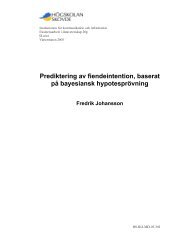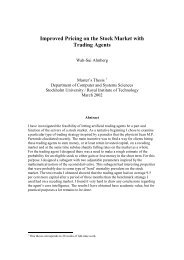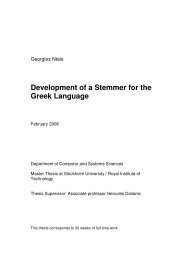Modeling Hydra Behavior Using Methods Founded in Behavior-Based Robotics
Modeling Hydra Behavior Using Methods Founded in ... - SAIS
Modeling Hydra Behavior Using Methods Founded in ... - SAIS
Create successful ePaper yourself
Turn your PDF publications into a flip-book with our unique Google optimized e-Paper software.
7.1. Generation of behaviors 37450400Latency vs. stimulus <strong>in</strong>tensityMeasured dataFunction approximation350Reaction time [s]3002502001501005000 10 20 30 40 50 60 70 80 90 100Relative light <strong>in</strong>tensity [%]Figure 7.7: Latency of response to light stimulus. In the function fitt<strong>in</strong>g, the measured responseto 6% relative stimulus <strong>in</strong>tensity was considered an outlier.7.1.3 B3: Respond to light stimulusSimilar to B2, response occurs by contraction or by locomotion. As discussed <strong>in</strong> Section5.1.3, upon exposure to light, there is an immediate <strong>in</strong>hibition of any ongo<strong>in</strong>g contraction.Follow<strong>in</strong>g a latency which depend on stimulus <strong>in</strong>tensity, a response is evoked. There isno habituation to repeated stimulus.Applicability clauseAs with B2, an event-driven AC was used. Activation of the AC occurs if M l > T l , whereT l was set to 0.2. The latency was modeled to fit the data obta<strong>in</strong>ed <strong>in</strong> [59]. Least squarefunction fitt<strong>in</strong>g was used, and the latency obta<strong>in</strong>ed wasL l = 24.15M l. (7.11)Fig. 7.7 illustrates the result obta<strong>in</strong>ed. Note that the measured data is a function of relativestimulus <strong>in</strong>tensity <strong>in</strong> percent, whereas read<strong>in</strong>gs from the light sensor <strong>in</strong> the modeled <strong>Hydra</strong>are taken <strong>in</strong> [0, 1]. The activation threshold, T l , also ensures that division by zero does notoccur <strong>in</strong> the calculations of L l .





